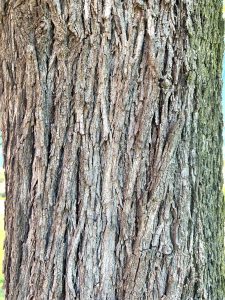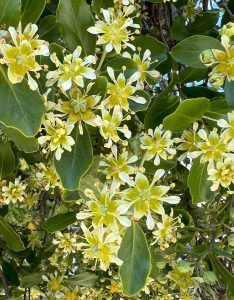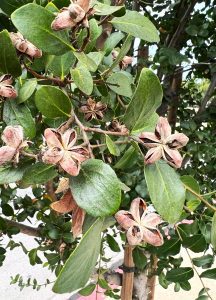Soapbark Tree: October 2023 Tree of the Month

Santa Barbara certainly has a well-deserved reputation as a horticultural mecca – it is now home to plants and trees that have been imported here, over the last 240 years, from all around the globe. Despite the many years that have passed, several species of these immigrant trees, including the Soapbark Tree, are still relatively unknown to members of our community.
Soapbark Tree was introduced into California in the late 1800s. While it is perfectly suited to our Mediterranean climate, only a few currently stand in Santa Barbara, primarily as street trees.
Its common name of “Soapbark Tree” refers to a compound, glycoside saponin, found in its bark. When water is added to it, this compound will create a lovely soft foam; as a result, it has long been used as a substitute for harsh lye-based soaps.
This is an evergreen tree that will reach 30- to 40-feet tall and 10- to 30-feet in width, with a rather irregular and asymmetrical canopy. When young, it is narrow and upright; as it matures, it tends to broaden and to develop a somewhat weeping growth habit.

Its crown is covered with shiny green leaves (1- to 1½- inches long and up to 1- inch wide). The leathery leaves are somewhat turgid and have toothed margins near the tips.
On young trees, the bark is light gray and smooth; with age, this turns dark gray with longitudinal furrows that sometimes spiral around the trunk.
As seen from a distance, Soapbark Tree can be confused with our native Coast Live Oak (Quercus agrifolia). Only close observation can aid in distinguishing the two very different species.
This tree generally goes unnoticed until May through June when it becomes covered in flowers. At peak bloom, there will be a profusion of small (1/2-inch across), five-petaled, creamy white flowers that appear in clusters, called corymbs, at the ends of the branches. The flowers are “perfect”, meaning each flower contains both male parts and female parts. They can be either self-pollinated or insect pollinated. The generous amounts of pollen and nectar they create attract a wide variety of insects, including bees, lacewings, lady beetles, and beneficial wasps. In Chile, the dark honey the bees produce from its flowers is highly prized.

Pollinated flowers develop a rosette of five-spoked follicles (¾- inch wide); when they ripen in the fall, these follicles turn brown and split open to disperse 10 to 20 seeds each.

Soapbark Tree is native to the temperate zone of central Chile, from the coast to elevations up to 6,500 feet, often in dry, poor soils; it is frequently found in association with the Chilean Wine Palm (Jubaea chilensis). There, the matorral and sclerophyll forests plant ecosystems are quite similar to our local chaparral and oak woodlands. In its native habitat, it is used for reforestation on arid sites.
It was once classified in the Rose family (Rosaceae) – but recently was assigned to its own family, Quillajaceae. Its botanical name is Quillaja saponaria. The genus name, Quillaja (pronounced key-YA-ha), is the name given to the tree by the indigenous Andean people. The specific epithet, saponaria, refers to the saponin compounds found in the bark.
Soapbark Tree has many uses. The inner bark is processed into a powder that has soap-like properties when mixed with water. The wood has a beautiful grain that is appreciated for fine carpentry and cabinetry. It has traditionally been used for medicinal purposes by the indigenous people of Chile. An extract from the tree, quillaia, is still used as an ingredient in pharmaceuticals, food additives, cosmetic products, perfumes, and fire-fighting foam. It should be noted that the glycoside saponins used in these substances can be toxic to humans and animals when ingested in large quantities.
The Soapbark Tree is a resilient and hardy tree that can tolerate drought, poor soils, and temperatures down to 15 degrees F. without damage. It should be planted in full sun. It looks best with occasional deep watering. It does not appear to be subject to any diseases or insect pests. Its root system is quite well-behaved, so it does not ordinarily disturb nearby paving or hardscapes. When young, it can require pruning to train its variable growth habit. Once established, it is otherwise a very low-maintenance sustainable tree. It has been used successfully as a street tree – but it also makes an attractive specimen tree, a tall hedge. or screen. If you want a tree that adds to the diversity and horticultural heritage of our community, the Soapbark tree would be an excellent choice.
Mature specimens of the Soapbark Tree can be seen in several places in our community: as park trees in West Alameda Park; in Pershing Park; in Franceschi Park; and, as street trees, on the first through 300 blocks of Castillo Street; on the 1500-1600 blocks of La Coronilla Drive; on the 800 block of Dolores Drive; and on the 300 block of East Victoria Street.
Tree-of-the-Month articles are sponsored by Santa Barbara Beautiful, whose many missions include the increase of public awareness and appreciation of Santa Barbara’s many outstanding trees and, in a long-time partnership with the City Parks & Recreation Department, the funding and planting of trees along the City’s streets.
Those who wish to honor a special someone can do so with an attractive commemorative marker that will be installed at the base of an existing street tree in the City of Santa Barbara. Because Santa Barbara Beautiful has participated in the planting to date of over 13,000 street trees, there are plenty of trees from which to choose! Application forms are available on the Santa Barbara Beautiful website, www.sbbeautiful.org.
Article and Photos by David Gress














